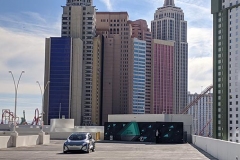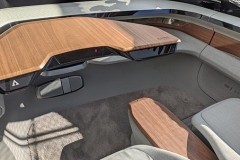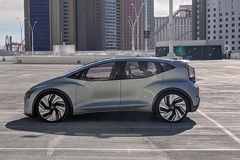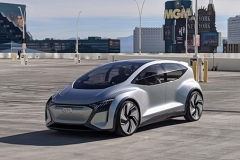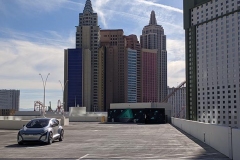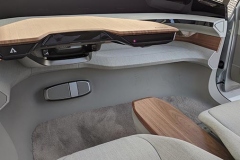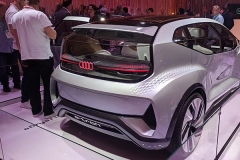Audi AI:Me concept at 2020 CES first drive
Audi’s centre piece at the 2020 CES (Consumer Electronics Show) was a functional, level 4 autonomous concept car, the Audi AI:Me. The electric powered urban car was originally shown at the 2019 Shanghai Auto Show. Since then, the concept has been further fleshed out and made operational. The AI:Me points to Audi’s vision of future urban vehicular use. 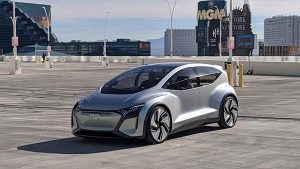
The Audi AI:Me rides atop a unique platform that allows for a small, urban friendly footprint with a surprisingly large interior cabin. The wheels have been pushed as far out towards the corners as they possibly can go, resulting in a larger amount of interior cabin space. The AI:Me wheelbase compares with an A4 Sedan, while the overall length more resembles that of a VW Golf.
Audi designers explained the concept as an evolution of the traditional mechanical ergonomic interaction with the customer. As the technology transforms, the AI:Me is more about how the car interacts with its occupants.
The working concept was brought to the rooftop of the Aria Resort and Casino parking lot for invited journalists to inspect and experience.
From a design perspective is unmistakably an Audi with the iconic trapezoidal front grille and illuminated Four Rings logos, front and back. Designers pointed out notable features integrated into the design. The elevated bend of the glass in the door windows which allows for increased shoulder room and a more spacious environment inside the cabin. LED lighting built into the four fenders interact with other vehicles and pedestrians around the car. The high visibility lighting, signals and warns if the vehicle is braking, accelerating or turning. 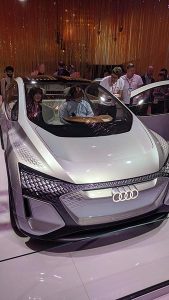
There is no centre pillar between the front and rear doors, which electrically pivot open from each end to create an unobstructed entrance to the AI:Me cabin. Sliding in, there’s a Scandinavian feel to the interior with light fabrics, light brown natural wood accents and an airy glass roof. A large wooden shelf sits ahead of the front seat occupants, which rests above black glass panels that serve as the touch interface with the vehicle’s controls and infotainment system.
An aviation style steering wheel and two touch-pads on the lower front wall that had to be an accelerator and brake pedal, show the AI:Me is ready for driver controlled operation. An engineer riding in back calls up an interface on his mobile phone and the steering wheel folds flat and slides forward under the wooden shelf, which rises and moves forward towards occupants. We were now in Autonomous mode.
Again with his phone, the engineer commenced a low speed lap of a mapped out route around the parking lot. The whole episode is akin to an amusement ride, a feeling perpetuated by the backdrop of the New York New York hotel roller coaster in our view. Topping off the carnival ride experience, the engineer hands us virtual reality goggles to wear.
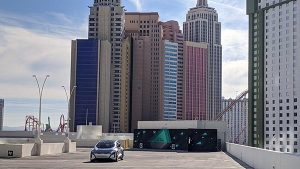 As the car moved, the VR goggles begin projecting a scene high above a mountain valley in China. Our perspective changed in sync with the motion of the car. The experience was similar to riding a helicopter through the valley, very cool! The demonstration was intended to show the possibilities available to entertain commuters in the future, once freed from the responsibility of vehicle operation.
As the car moved, the VR goggles begin projecting a scene high above a mountain valley in China. Our perspective changed in sync with the motion of the car. The experience was similar to riding a helicopter through the valley, very cool! The demonstration was intended to show the possibilities available to entertain commuters in the future, once freed from the responsibility of vehicle operation.
Technology fitted in the car includes infrared sensors that follow the occupants movements and in particular eye movement tracking. Focus on an icon contained on screen and the car reacts by choosing that feature. We were able to order lunch based on visual choices on the screen, which was waiting for us at the end of the “drive”. Audi engineers explained that the AI:Me was developed with car sharing as a prime use and have focused on vehicle customization based on individual operators. The vehicle will be able to recognize individuals and also learn from their habits in the car.
Technically, the AI:Me is fitted with a 65 W/hr lithium-ion battery that feeds motors driving the rear wheels.
The Audi AI:Me remains as a concept and not currently slated for production. Regulatory hurdles remain for Autonomous driving. However, engineers admit that portions of the vehicle, most notably the interior features, exterior lighting and driver interface, could find their way into production vehicles in short order. Eye motion interface will be game changer in-terms of in-vehicle ergonomic interface.
Audi Media site has further information on the concept.
Copyright © Auto Reviews Online 2016 | Privacy & Terms of Use | info@autoreviewsonline.com | Website by Brolly Media

